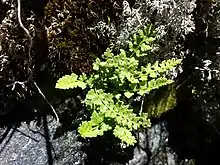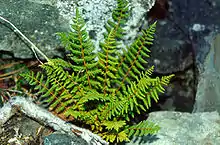| Woodsiaceae | |
|---|---|
 | |
| Woodsia alpina | |
 | |
| Physematium oreganum | |
| Scientific classification | |
| Kingdom: | Plantae |
| Clade: | Tracheophytes |
| Division: | Polypodiophyta |
| Class: | Polypodiopsida |
| Order: | Polypodiales |
| Suborder: | Aspleniineae |
| Family: | Woodsiaceae Herter[1] |
| Genera | |
|
See text. | |
Woodsiaceae is a family of ferns. In the Pteridophyte Phylogeny Group classification of 2016 (PPG I), it is placed in the suborder Aspleniineae.[1] The family can also be treated as the subfamily Woodsioideae of a very broadly defined family Aspleniaceae sensu lato.[2] In PPG I, the family contained only one genus, Woodsia. In 2020, Physematium was split off from Woodsia on the basis of molecular phylogenetic evidence.[3] As of June 2023, Plants of the World Online continued to treat Physematium as a synonym of Woodsia.[4]
Taxonomy
Woodsiaceae formerly included the members of the families Athyriaceae and Diplaziopsidaceae, but analysis has consistently shown that they should be treated as separate families.[5] The following cladogram for the suborder Aspleniineae (as eupolypods II), based on Lehtonen (2011),[6] and Rothfels et al. (2012),[7] shows a likely phylogenetic relationship between the Woodsiaceae and the other families of the Aspleniineae.
| Aspleniineae (eupolypods II) |
| ||||||||||||||||||||||||||||||||||||||||||||||||||||||
A molecular phylogenetic study published in 2020 largely confirmed the position of the family. It included 122 accessions representing about 43 species then placed in the sole genus Woodsia. It showed that Woodsia was deeply divided into two clades, which the authors recognized as two genera Physematium and Woodsia.[3]
Genera
As of June 2023, World Ferns accepted three genera:[8]
- Physematium Kaulf.
- Woodsia R.Br.
- × Woodsimatium Li Bing Zhang, N.T.Lu & X.F.Gao = Woodsia × Physematium
Distribution
Species of Woodsia are native to northern North America and Eurasia, and further south in the east of Asia, from western mainland China to Taiwan. Although the distributions overlap, species of Physematium generally have a more southern distribution, being found further south in North America and in northern South America as well as in Asia, with a few species in Africa and Madagascar.[3]
References
- 1 2 PPG I (2016), "A community-derived classification for extant lycophytes and ferns", Journal of Systematics and Evolution, 54 (6): 563–603, doi:10.1111/jse.12229, S2CID 39980610
- ↑ Christenhusz, Maarten J.M. & Chase, Mark W. (2014), "Trends and concepts in fern classification", Annals of Botany, 113 (9): 571–594, doi:10.1093/aob/mct299, PMC 3936591, PMID 24532607
- 1 2 3 Lu, N.T.; Zhou, X.-M.; Zhang, L.; Knapp, R.; Li, C.-X.; Fan, X.-P.; Zhou, L.; Wei, H.-J.; Lu, J.-M., Xu, B.; Peng, Y.-L.; Gao, X.-F. & Zhang, L.-B. (2020), "A global plastid phylogeny of the cliff fern family Woodsiaceae and a two-genus classification of Woodsiaceae with the description of ×Woodsimatium nothogen. nov.", Taxon, 68 (6): 1149–1172, doi:10.1002/tax.12180, S2CID 213706008
{{citation}}: CS1 maint: multiple names: authors list (link) - ↑ "Physematium Kaulf.", Plants of the World Online, Royal Botanic Gardens, Kew, retrieved 2023-06-13
- ↑ Christenhusz, Maarten J.M.; Zhang, Xian-Chun & Schneider, Harald (2011), "A linear sequence of extant families and genera of lycophytes and ferns", Phytotaxa, 19: 7–54, doi:10.11646/phytotaxa.19.1.2
- ↑ Lehtonen, Samuli (2011), "Towards Resolving the Complete Fern Tree of Life" (PDF), PLOS ONE, 6 (10): e24851, Bibcode:2011PLoSO...624851L, doi:10.1371/journal.pone.0024851, PMC 3192703, PMID 22022365
- ↑ Rothfels, Carl J.; Larsson, Anders; Kuo, Li-Yaung; Korall, Petra; Chiou, Wen-Liang; Pryer, Kathleen M. (2012), "Overcoming Deep Roots, Fast Rates, and Short Internodes to Resolve the Ancient Rapid Radiation of Eupolypod II Ferns", Systematic Biology, 61 (1): 490–509, doi:10.1093/sysbio/sys001, PMID 22223449
- ↑ Hassler, Michael, "Woodsia", World Ferns, retrieved 2023-06-13